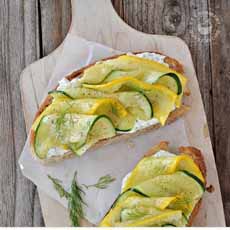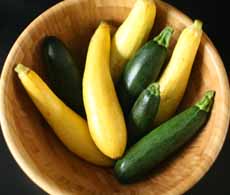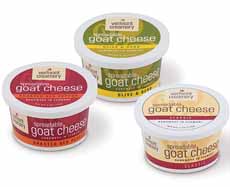RECIPE: Summer Squash Crostini With Goat Cheese
|
Don’t let summer slip away without trying this sunny bruschetta, for breakfast, lunch, snack, or a first course at dinner.
It was created by Kelley Epstein of Mountain Mama Cooks (her mountain is in Park City, Utah). The recipe was sent to us by Vermont Creamery. You can use flavored goat cheese instead of plain. Vermont Creamery makes Creamy Goat Cheese in Classic, Olive & Herb, and Roasted Red Pepper, all of which work well with summer squash. If you don’t have spreadable goat cheese, use a goat cheese log at room temperature, which makes it more spreadable. Below, the difference between crostini and bruschetta. Ingredients For 4 Large Or 8 Small Pieces 1. SLICE the zucchini and yellow squash as thinly as possible, using a mandoline or sharp knife. 2. COMBINE the squash, olive oil, lemon juice, salt, and pepper in a large bowl. Let it sit for 30 minutes or so until ready to serve. Then… 3. GRILL the baguette slices. While they grill… 4. COMBINE the goat cheese mixture in a food processor with the dill, lemon zest, and pepper. Pulse until smooth and incorporated. 5. SPREAD the goat cheese on each slice of bread and top with zucchini and yellow squash. Top each bruschetta with extra fresh dill and a sprinkle of kosher or coarse sea salt and pepper, if desired. The answer, in brief, is the size of the slice, plus grilling versus toasting. |
 [1] Eat your vegetables…on bruschetta or crostini. The differences are below (this photo shows bruschetta, a larger slice that is grilled instead of toasted; photo © Mountain Mama Cooks).
|
|
|
Bruschetta (three or four inches in diameter) are cut from an Italian loaf and grilled; crostini (about two inches in diameter) are cut from a thinner loaf like a baguette, and toasted. Bruschetta (pronounced broo-SKEH-tuh) are grilled bread rubbed with garlic and topped with any variety of items. The toppings can be as simple as extra-virgin olive oil, salt, and pepper, to diced tomatoes and basil, to almost any spread, vegetable, cured meat, or cheese—even fruit. Bruschetta originated in the Tuscany region of Italy, where it is commonly served as a snack or appetizer. It may have been the original garlic bread. The word comes from the verb bruscare in the Roman dialect, which means “to roast over coals.” If you have access to a grill, grill the bread for authenticity. If not, you can toast it. Some American manufacturers and others in the food industry misuse the term, using it to refer to the topping only and selling jars of “bruschetta” (it should be bruschetta topping). Show your superior knowledge and don’t allow the term to be distorted: The word bruschetta refers to the grilled bread, not the topping. Crostini (cruh-STEE-nee) are croutons: not in the American sense of small cubes tossed into soup or salad, but thin slices of toasted bread. Smaller than bruschetta, the slices can be cut from a ficelle, a thinner baguette one to two inches wide (the word is French for “string”), or from a thinner baguette. The slices are brushed with olive oil, toasted, and then topped with spreadable cheese, pâté, or other ingredients. Plain crostini are served with soups and salads, like melba toast, or set out with cheese. Final take: CHECK OUT WHAT’S HAPPENING ON OUR HOME PAGE, THENIBBLE.COM. |
||




